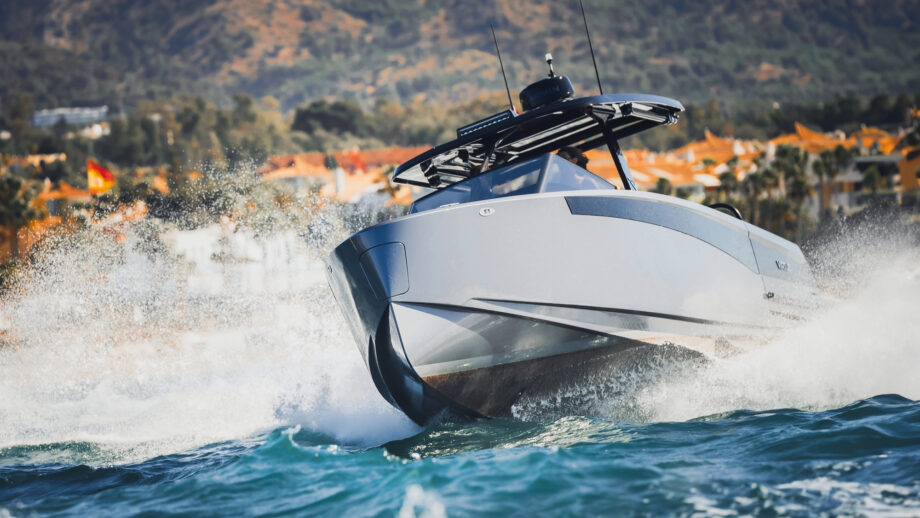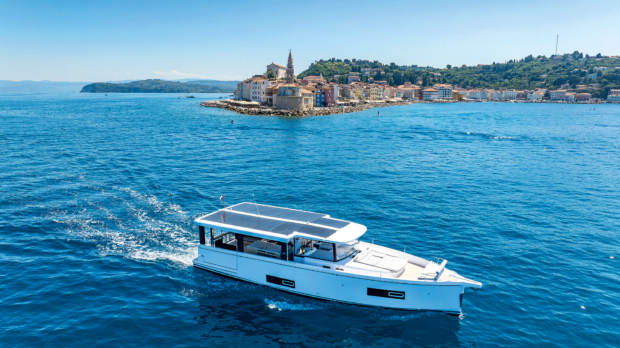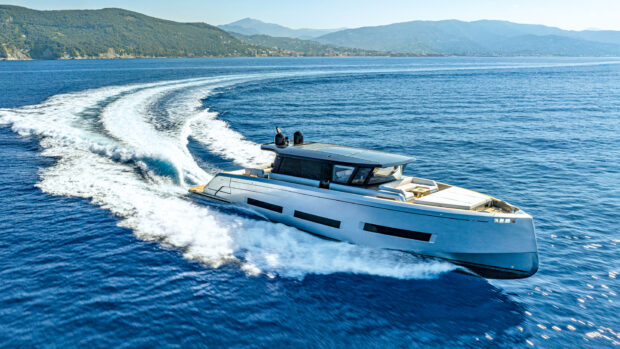Is this the boat that finally brings clarity to the world of the Scandi weekender? Alex Smith tests the Virtue V10 to find out
How many builders could you name with boats that look broadly like the Virtue V10? A dozen perhaps? From Ryck, Sterk, Quarken and Saxdor to Axopar, Pardo, Fjord and Schaefer, it’s a region of the market with plenty of buying options but precious little in the way of obvious design divergence.
What we tend to expect (and what we tend to get) is a plumb bow, a compact cuddy cabin, a set of walkaround decks and some outboard engines. An aft cockpit with a facing dinette, a transverse wet bar and a two- or three-man helm is also par for the course; and key options tend to include a T-top and a set of cockpit-expanding drop-down terraces.
So as we amble toward the new Virtue V10 on its Palma pontoon, we’re keen to see something that can genuinely subvert the Scandi weekender blueprint – and according to the guys at Virtue, the new V10 is exactly that boat.

With its cool styling, Petestep hull and high-spec fit-out, Virtue is aiming for the upper end of the market
How is the Virtue V10 different?
At first glance, the key difference with the Virtue V10 appears to be that it looks and feels just a little bit posher than the market average. The cleats are sunken, the grab rails are recessed into the bulwarks in the Windy style, and the use of carbon-fibre trim is extremely generous.
A pair of drop-down terraces on either side of the dinette comes as part of the standard package and the styling is also distinctly high end. The hull windows are conspicuous by their absence, in a (broadly successful) bid to preserve the V10’s purity of line; and the anchor is tucked away behind a flush-mounted hatch at the stem, very much in the fashion of an A-list Italian motor yacht.
That anchor though is about more than just style, because the Virtue V10’s overall proportions (stopping just short of 10m in length and 3m in the beam) are deliberately designed to fit the most common Mediterranean berths – and if that reveals the kind of environment where this boat is likely to have the greatest appeal, both the build quality, which is strong, and the price, which is significant, help back that up.

In spite of its aggressively sporty styling, the V10’s handling is very accessible
The enormous options list also plays into the appetites of high-end Mediterranean day boaters who want something that feels just that bit more customised and individual than the average production boat. But the most obvious difference on the new Virtue V10 is actually to be found below the waterline.
Designed in Sweden, the patented Petestep hull features a set of acutely angled spray rails that fan out from the keel towards the topsides, deflecting spray downwards and backwards, rather than sideways. The idea behind this is to harness the energy of the displaced water to create additional lift, reduced drag, uprated efficiency, increased speed and (so they would have us believe) a softer ride.
Irrespective of the style and design flair on offer here then, the first thing we’re going to do is take the Virtue V10 out for a drive…
Article continues below…

Quarken 35 T-Top first look: Open-plan with pilothouse echoes

XO DFNDR 8 sea trial review: Nordic four-season boat with mind-blowing performance
A 43-knot pussycat
When you step in at the helm, the Virtue V10 feels a touch tight for a six-footer. It doesn’t quite give you the fore-and aft space to drop your bum down and jam your feet against the foot brace, and the fact that the seats are mounted on the leading edge of the galley limits their travel as you try to adjust them aft.
That means that when you nestle against the bolster, your head is a shade too high for the raked wraparound screen to provide much protection. That becomes particularly evident during an impromptu rainstorm, but even when we sit down, our elevation means we’re still jabbed in the face by 40-knot pin-prick raindrops.

The bow is deep, tapered and attractively trimmed
Still, the seats themselves come with impact mitigation as standard and the general helm environment is very attractive. It features a pair of 12in plotters, protective sidescreens and a supremely stylish F1-inspired carbon fibre ‘Halo’ strut between the dashboard and the T-Top.
As for the drive, though, we’re not quite convinced by the claims made in relation to the Petestep hull. The principle of directing water downwards rather than outwards certainly makes good sense but in practice, it seems neither any softer, nor any more efficient than a conventional hull.
That said, this is a good boat to drive, with a very accessible blend of grunt, agility and novice-friendly manners. A hard turn, for instance, involves as much slip as it does grip and if you over-trim this boat, it doesn’t become wayward or uncertain. It simply aerates the props and washes off the pace, enabling you to learn from the experience, tuck the legs back in and go again.

With its concealed anchor and window-free hull, the V10 is a very pretty boat
In fact, it’s by no means a hard-edged or uncompromising driver’s boat in any regard and that makes it all the better for family boating.
The dynamic between price, range, performance and application is a very interesting one though. At just 420L, the modestly sized fuel tank only delivers a cruising range of between 100 and 135 miles from the test boat’s twin Honda BF250 outboards, so if you don’t mind easing back on the test boat’s 43-knot top end, you could reduce the price, weight and running costs with a single 300hp unit. With a rig like that, you might be able to reduce the cruising fuel flow by around 30lph and the full-throttle fuel flow by about 60lph, while still pushing on into the high 30 knots.
You could go even further too, either by dropping down to a single 250 or by changing the game with a pair of Evoy electric outboards. And if you want to go the other way, tweaking the speed to match the V10’s go-faster aesthetic, you could increase the top end to around 50 knots with a pair of 300s instead.
In all cases, it’s clear that the performance, like the fit-out, can be precisely tailored to the way you like to go boating.

The entry point to the cabin is surprisingly bright
Standard layout, sexy finish
As intimated, the deck layout offers no great surprises. At the back end, symmetrical swim platforms frame the outboards, with a lifting platform to make your way between the two sides and a fold-out ladder beneath a hatch to starboard. Ahead of this, the cockpit is arranged around a transverse dinette with a couple of hinged backrests and a drop-down table that enables you to turn the entire space into an unbroken sunbed.
A pair of impressively scaled drop down terraces on either side of this expands the deck exactly where it’s most useful, and further forward, the transverse galley features a pair of fridges, an electric hob and a sink. In truth, the galley lid is too heavy for the rams to handle but it’s a good size and well placed to serve your cockpit guests.

The cockpit dinette can be filled in with the drop-down table or folded flat above the swim platform
There’s a very tangible sense of quality here too, thanks to the powder-blue upholstery, the stylish T-top with integrated solar panels and the walkaround decks with deep bulwarks and inset grab rails. As you make your way toward the bow, the grab rails on the sides of the T-top could do with recessing into the moulding in a similar fashion to help minimise the risk of banging your head, but the bow itself provides a cool island sun bed for two with a simple pull mechanism to extend the length and shallow the angle of the headrest.
As regards the overnighting facilities, the fact that this is a heavily tapered platform with very substantial side decks means the V10 leans very much toward day boating over cruising but it still provides the basics you need for a weekend away.
There’s a double berth in the bow, a small changing seat to port and a separate heads compartment with the option of a shower fitting to starboard. It’s arranged very much in the form of the classic cuddy, so you can’t stand up straight and, hard though we search, additional features like reading lights and power points seem to be entirely missing from the test boat.
But the ambience remains pretty good. Despite the absence of any letter slot windows built into the foredeck’s raised island sunbed, a pair of large side windows at the entry point to the cabin means that natural light is actually very decent.

Very few competitors provide twin terraces as standard
Virtue V10 specifications
LOA: 32ft 8in (9.95m)
BEAM: 9ft 6in (2.90m)
DRAFT: 3ft 10in (1.17m)
DISPLACEMENT: 15,100kg (light)
FUEL CAPACITY: 420 litres
WATER CAPACITY: 100 litres
ENGINES: From single 250 to twin 300hp outboards
RCD: B12
CONTACT: virtue-yachts.com
Virtue V10 costs and options
From £153,575 ex VAT.
Twin Honda BF250s £30,727
Air conditioning £8,803
Solar panels £2,034
Carbon fibre trim £4,487
Twin 12in plotters £7,179
 If you enjoyed this….
If you enjoyed this….
Motor Boat & Yachting is the world’s leading magazine for Motoryacht enthusiasts. Every month we have inspirational adventures and practical features to help you realise your sailing dreams, as well as tests and news of all the latest motorboats.
Plus you’ll get our quarterly Custom Yachting supplement where we share the last on offer in the superyacht world and at the luxury end of the market.
Build your knowledge with a subscription delivered to your door. See our latest offers and save at least 30% off the cover price.
Price as reviewed:
£153,575.00 Base price ex. VAT
Verdict
This is a very competent boat in a very competitive category. It’s stylish and well built with a subtly upmarket feel, a strong spec and a well-judged extras list. It’s easy to drive, it handles well and it offers a variety of engine options, including electric. The fact that the drop-down terraces come as standard is also a major bonus and we have no doubt that the carbon-fibre trim will sweeten the deal for some. But aside from the Petestep hull, which differs more in concept than impact, there is nothing here that you could describe as genuinely fresh; nothing to really set it apart from the many capable boats that already inhabit this part of the market. So by all means, if you want a slick, sporting day boat with the potential for the odd night away, then the V10 deserves to be a very real part of the conversation. But if you’re looking for a boat that trumps the existing players and brings definitive clarity to this fiercely contested market segment, the arrival of the Virtue V10 is only likely to complicate the issue.





 If you enjoyed this….
If you enjoyed this….





